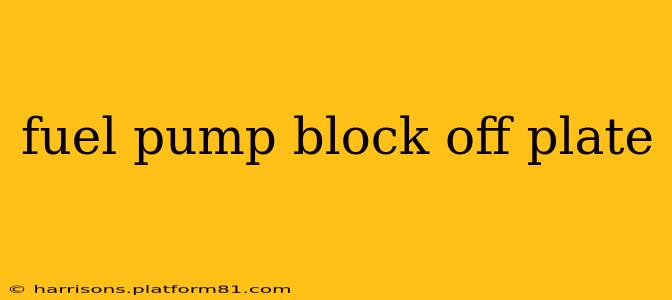A fuel pump block off plate is a simple yet crucial component for vehicles undergoing modifications, particularly those involving engine swaps or fuel system changes. This guide delves into the reasons for using a fuel pump block off plate, installation procedures, potential issues, and frequently asked questions.
Why Use a Fuel Pump Block Off Plate?
The primary reason for installing a fuel pump block off plate is to disable the original fuel pump in situations where it's no longer needed. This is common in several scenarios:
- Engine Swaps: When replacing an engine, the original fuel pump may be incompatible with the new engine's fuel system requirements. A block off plate prevents the old pump from interfering with the new system.
- Fuel System Upgrades: If upgrading to a higher-performance fuel system, such as an aftermarket fuel pump, the original pump becomes redundant. Blocking it off avoids potential conflicts or issues with pressure regulation.
- Troubleshooting: During fuel system diagnostics, temporarily blocking off the fuel pump can isolate problems and help determine the root cause of fuel delivery issues.
- Cost Savings: Removing and replacing the fuel pump can be expensive. A block-off plate offers a budget-friendly alternative when the pump is no longer required.
What Happens if You Don't Use a Fuel Pump Block Off Plate?
Leaving the original fuel pump active when it's unnecessary can lead to several problems:
- Reduced Fuel Efficiency: An unnecessary fuel pump will continue to draw power from the vehicle's electrical system, leading to slightly reduced fuel economy.
- Potential Damage: If the original fuel pump is incompatible with the new fuel system, it might be damaged or cause damage to other components.
- System Conflicts: The old pump may interfere with the operation of a new, high-performance fuel system, leading to inconsistent fuel delivery and potential performance issues.
- Leaks: An old, damaged, or improperly sealed fuel pump could cause fuel leaks.
How to Install a Fuel Pump Block Off Plate
The installation process typically involves removing the old fuel pump and replacing it with the block off plate. This is a relatively straightforward process, but it's crucial to follow the specific instructions provided with your chosen block off plate and consult a repair manual for your vehicle's make and model. Safety precautions, such as disconnecting the battery, should always be observed when working with fuel systems. Improper installation could lead to leaks or other malfunctions. If you are not comfortable performing this task yourself, consult a qualified mechanic.
What Tools Do I Need to Install a Fuel Pump Block Off Plate?
The specific tools required may vary depending on the vehicle and the block off plate design, but generally, you'll need basic hand tools, including wrenches, sockets, and possibly a sealant.
Choosing the Right Fuel Pump Block Off Plate
Choosing the correct block off plate is crucial. Ensure the plate is specifically designed for your vehicle's make, model, and year. Verify compatibility with your fuel system configuration to ensure a proper and safe fit. Read customer reviews before making a purchase to assess the quality and reliability of the product.
Can I Make My Own Fuel Pump Block Off Plate?
While it's theoretically possible to fabricate a block off plate, it's generally not recommended. A professionally manufactured plate is designed for a precise fit and seal, minimizing the risk of leaks or other problems. Improperly fabricated plates could compromise the integrity of your fuel system, posing safety risks.
What Materials Are Fuel Pump Block Off Plates Made Of?
Fuel pump block off plates are typically made from durable materials like aluminum or steel, ensuring longevity and resistance to corrosion. The material should be compatible with the fuel system to prevent reactions or damage.
Conclusion
A fuel pump block off plate is a valuable component for various vehicle modifications and repairs. Understanding its purpose, proper installation, and potential issues is critical for maintaining a safe and efficient fuel system. Always prioritize safety and consult a professional if you're unsure about any aspect of the installation process.
